North of Bangkok lies the former capital Ayutthaya. Here you can cycle around to some of Thailand’s most famous temples and historical ruins. In this comprehensive guide, we’ve shared our favorite temples, plus practical tips on a cycling route, accommodation, transport, and more.
Written by Mette / Photo by Martin
Translated from Danish
Just a few hundred years ago, Ayutthaya was one of the world’s largest cities. Bigger than London at the time, legendary as Angkor Wat, and the capital of Thailand until 1767. Somehow all these facts had escaped us before visiting the old royal city, which was the first stop on our journey up through Northern Thailand.
We had heard about the city because it is a popular day trip from Bangkok – for good reason. But we had also noticed the name, as it is almost impossible to look at pictures from Thailand without coming across the famous Buddha head, which has mysteriously grown into the roots of an old tree.
A brief history of Ayutthaya
Ayutthaya flourished from the middle of the 14th century, when the royal power was moved here from Sukhothai in Northern Thailand and the city was established as the capital of the kingdom of Siam – what is today known as Thailand.
Historical sources tell of an unparalleled metropolis with 400 temples, beautiful palaces, modern urban planning, and a vast wealth attracting traders and explorers from all over the world. About kings who fought for power on the backs of war elephants, but who also knew how to keep European colonists at the door with diplomatic skills.
The power and beauty of the Ayutthaya existed for 417 years. The adventure ended in 1767 when the Burmese army invaded the city and left it in ruins. The royal family and the city’s residents fled down the river and established the current capital of Thailand, Bangkok.
Today, Ayutthaya is a provincial Thai city that doesn’t immediately exude an Indiana Jones adventure. But if you take the time to explore the city’s many impressive temples and historic sites, the story of a golden kingdom is brought to life.
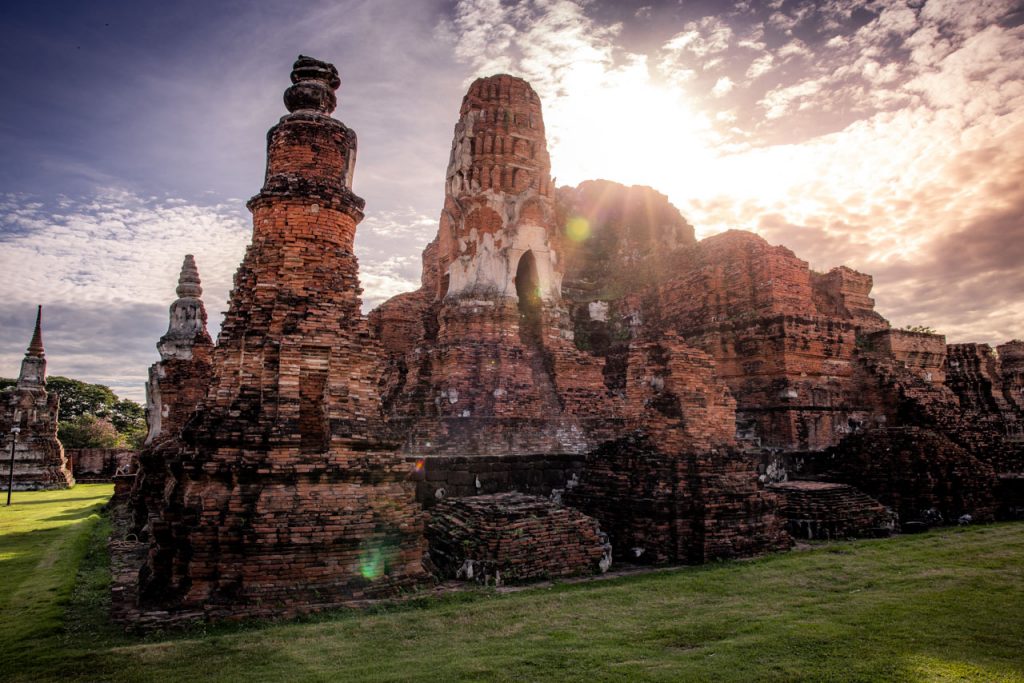
THE MOST FAMOUS TEMPLES OF AYUTTHAYA
PLUS A CYCLING ROUTE
Ayutthaya has more ruins, temples, and Buddha statues than you can manage to explore in a day. Therefore, we have listed our favorites among the most famous. If you visit the temples in order, they make up a full-day trip by bike.
#1 – Wat Ratchaburana and the white tower
The temple tower is a breathtaking sight as you walk through the ancient entrance to the complex. Compared to the neighboring red-brick temples, Wat Ratchaburana’s white and detailed splendor stands out. Take the stairs to the top, where you have a view beyond the park. Inside the tower, you will find a staircase to a crypt with several Buddha carvings.
The temple was built in 1424 by King Borom Rachathirat II on the site where his two brothers were buried – after they had killed each other in the fight for the throne. The story goes that the battle took place on the backs of war elephants.
We recommend that you start your cycling trip here. Wat Ratchaburana is among Ayutthaya’s star attractions, so arrive early to avoid the hordes of day-trippers.
Entrance fee: Single entry 50 baht, or 220 bhat for a temple pass
Opening hours: 8-16.30
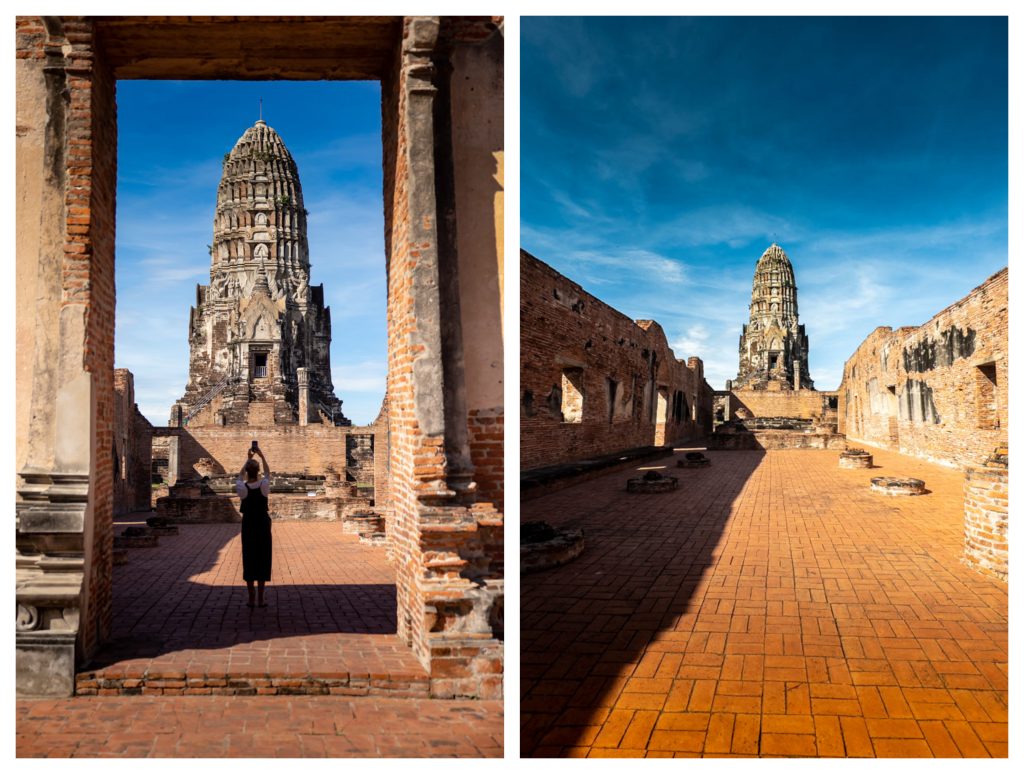
#2 – Wat Mahathat and the famous Buddha head
The tempel is Ayutthaya’s most famous and you may have seen pictures from here without knowing it. Here you will find the stone-carved Buddha head mysteriously entangled in the roots of an old tree.
It’s an interesting sight, but for us the experience can be somewhat compared to The Little Mermaid in Denmark. We thought the Buddha head was somewhat larger than it actually is. In addition, a selfie bench has been built in front of the tree. It makes it easier to find the head, which takes some of the magic away. And we had – perhaps a little naively – been looking forward to a treasure hunt.
On the other hand, we understand why the temple complex is one of the most popular in Ayutthaya. It is a larger area where you can explore the remains of magnificent buildings, pillars, stupas, and Buddha figures. It was built in 1374 by King Borom Rachathirat I and gives a sense of the royal city’s bygone glory days.
Wat Mahathat is next to Wat Ratchaburana, but they each have separate entrances and are separated by Naresuan Road. Park the bike at the parking lot next to the temple entrance, where you’ll also find nice public toilets (10 bhat).
Entrance fee: 50 baht, or 220 bhat for a temple pass
Opening hours: 8-18
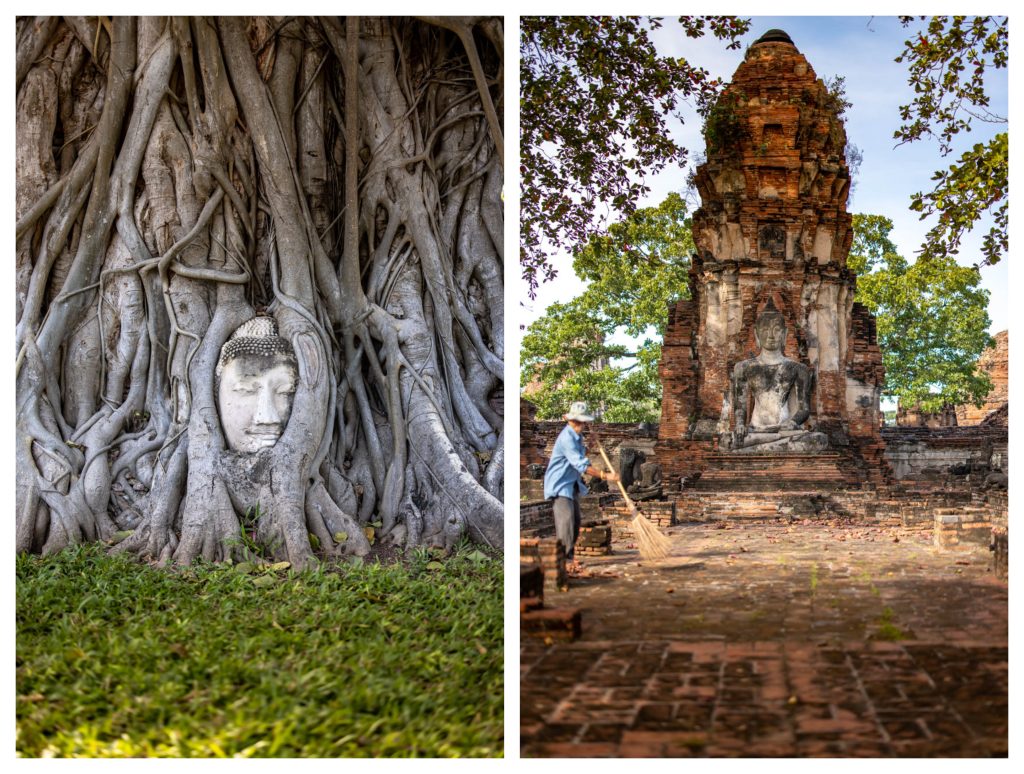
#3 – Coffee break at Bueng Phra Ram Temple Park
Ayutthaya is known for being scorching hot and the sun already starts to bake at 10 am. Therefore, a good tip is to make a stop at one of the cafes located opposite the entrances of Wat Mahathat. Here you can buy water and an iced coffee to go before you continue your temple run. We can recommend e.g. Coffee Old City, Prang View, or the coffee bar Kayim.
Now grab your bike and zigzag your way through the green park, Bueng Phra Ram. The path takes you along the walls of Wat Mahathat, along small lakes, and across bridges. From here you can enjoy the greatness of the temples, as you can observe them from a distance.
Along the way in the park, you will also pass smaller ruins that virtually no one visits. Or, that is, maybe you have to share the view with the monitor lizards sunbathing along the lakeshore. The path leads you to the backend of our next temple stop, Wat Phra Ram. If you cycle directly on the main road, it takes a maximum of 10 minutes.
Entrance fee: Free
You will find the beginning of the path to the left of the entrance to Wat Mahathat
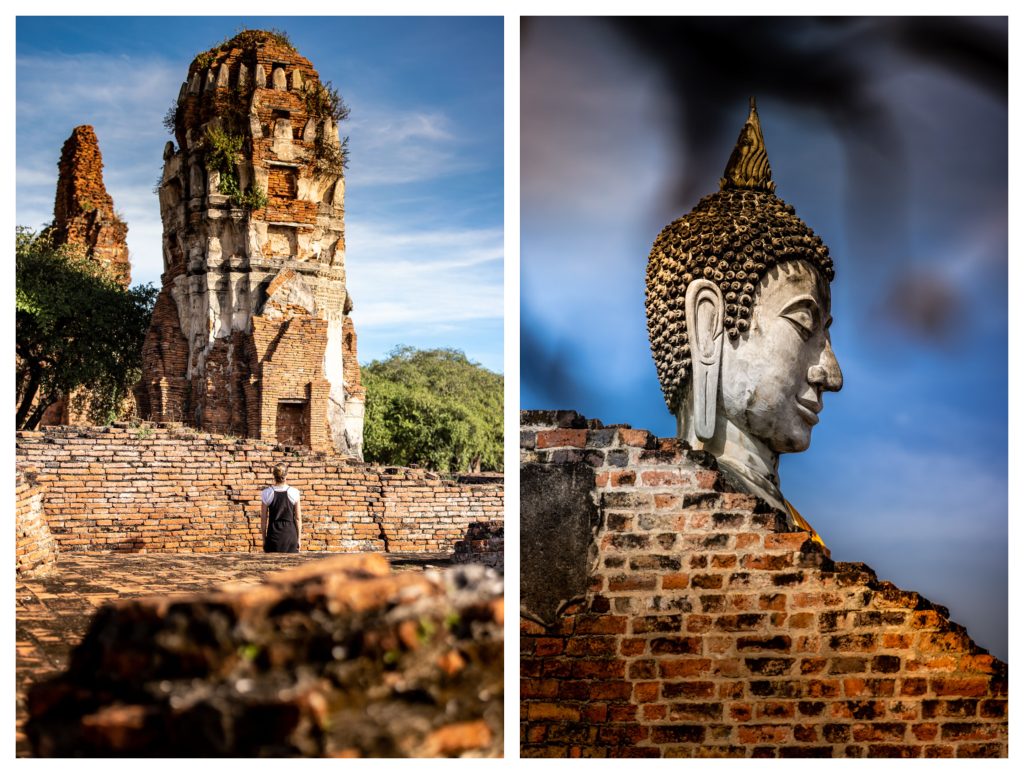
#4 – The peaceful Wat Phra Ram
The temple complex is smaller than Wat Ratchaburana and Wat Mahathat. But the temple tower is known to be among Ayutthaya’s finest. Additionally, the temple is not on the day trip route, so walking around the ruins is a peaceful and more authentic experience. For us, this is a good reason to pass by.
The splendor of the temple is particularly evident when you arrive and walk through the ancient entrance. Or if you stand outside the complex, where the temple is reflected in the water southwest of the entrance. Unfortunately, the sun was behind clouds when we cycled past. But looking at the official pictures from a perfect sunny day, the reflection makes us remember our visit to Angkor Wat.
Entrance fee: 50 bhat, or 220 bhat for a temple pass
Opening hours: 8-16.30
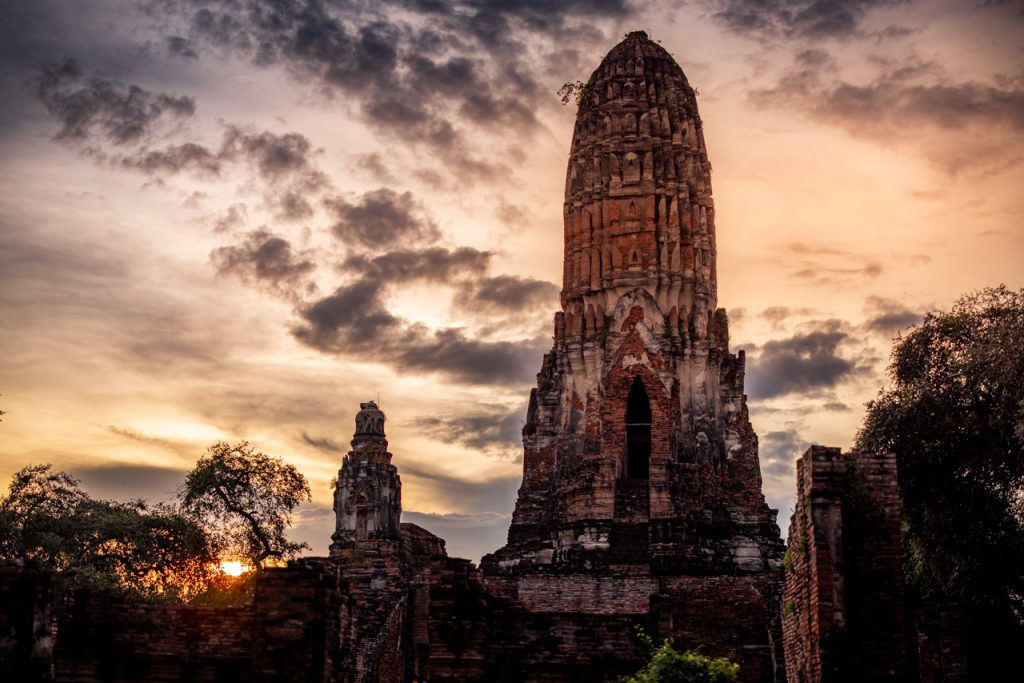
#5 – The iconic palace Wat Phra Si Sanpet
The temple, also known as the Grand Palace, is Ayutthaya’s largest and one of Thailand’s most iconic. Built as a private chapel for the Ayutthaya dynasty in 1448, it stands out for its three large bell-shaped pagodas, where former kings and members of the royal family are believed to be buried.
Right next to the complex you will find Wihan Phra Mongkhon Bophit. A modern temple as you most often know them in Thailand. With large white pillars, a shiny tiled roof, and gilded spires. The temple houses a 12-meter-high Buddha and is frequently visited by the locals. The temple was built in 1956 with the help of Burma, as atonement for the destruction committed 200 years earlier.
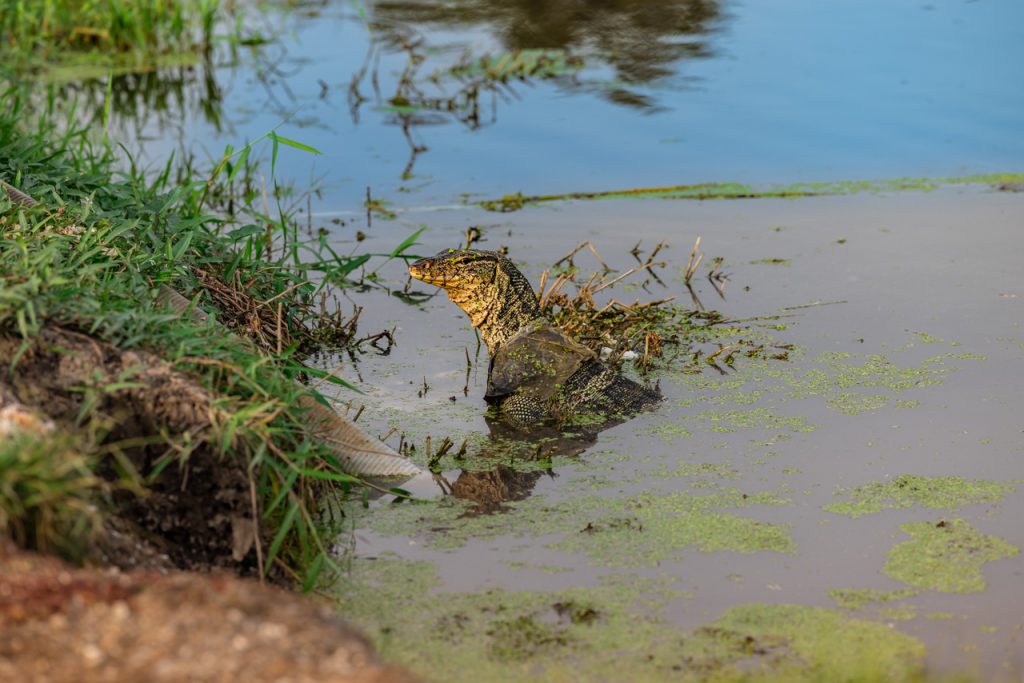
#6 – Lunch and lions at Wat Thammikarat
If you’ve got blood on your temple teeth and want to visit more ruins, you can cycle a short detour to Wat Thammikarat. It is a smaller complex and with few visitors. Here the most interesting detail is the remains of lion figures guarding the temple. It’s free to visit and is a great little pitstop before or after your lunch break.
We cycled there via Naresuan Road, which appears to be a back entrance. The main entrance is on U Thong Road, which is slightly larger. Here you will find local eateries and small cafes, for example the stylish Busaba Café & Meal. Alternatively, you can lunch at one of the restaurants around Khlong Tho Road, eg Ta Seng Noodle, before cycling on to the next temple.
Entrance: Free
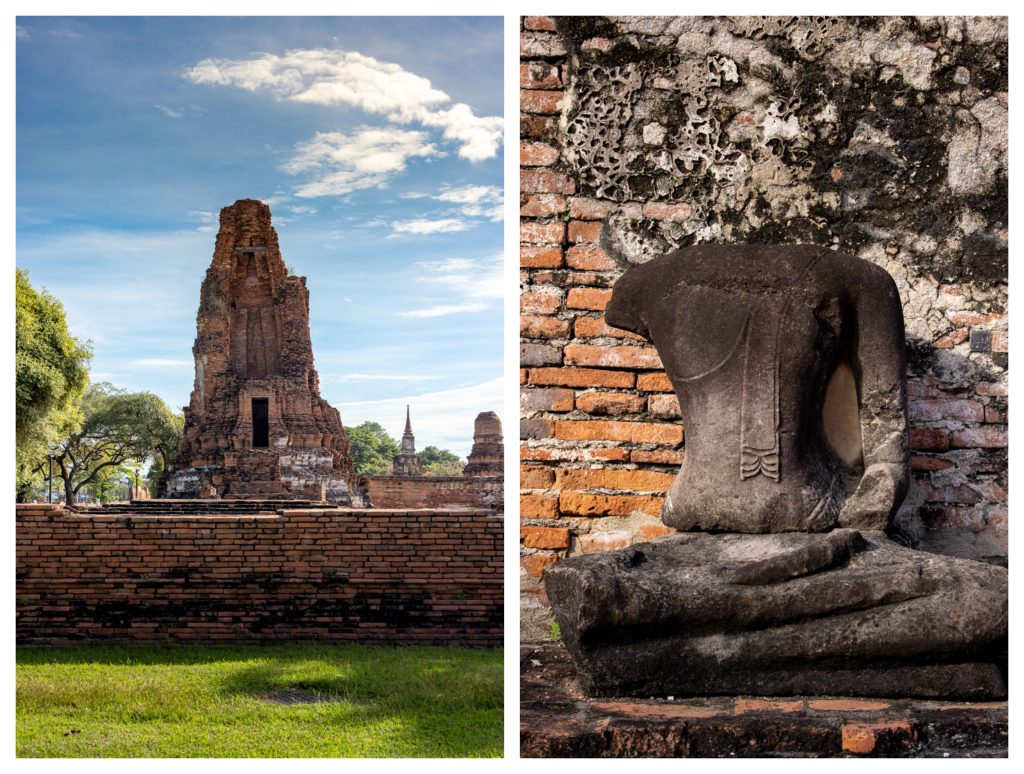
#7 – Big Buddha at Wat Lokaya Sutharam
After a day with countless headless Buddhas, you might want to see an intact figure – and in addition Ayutthaya’s biggest one. You will find it approx. 10 minutes cycling from Wat Thammikarat. Not much remains of the temple itself, Wat Lokaya Sutharam, but the reclining Buddha is one of the largest we have seen.
He was said to be 42 meters long and 8 meters tall, and for us, it was the size of the figure that was the real attraction. The Buddha is a bit out of the way. So, if you are getting a bit overwhelmed by the numbers of ruins, temples, and Buddhas on one day, we would recommend that you skip the stop. But if Buddha figures are fuel for your bike, then you should pay him a visit, plus swing past the small neighboring temple, Wat Worachettharam.
Entrance: Free
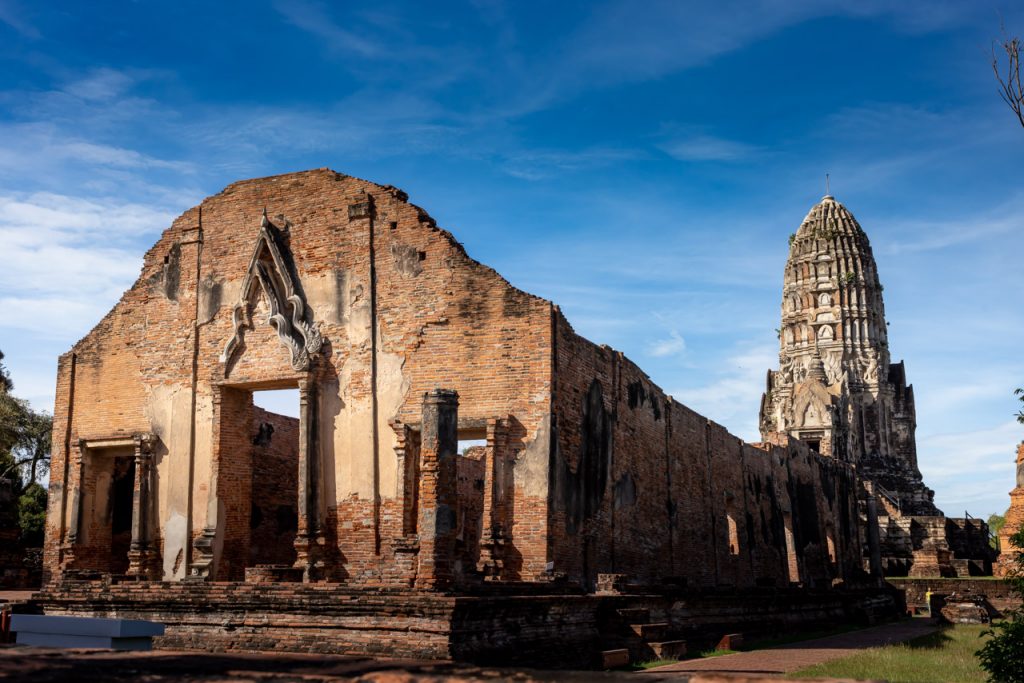
#8 – Wat Chaiwatthanaram, a popular sunset spot
The temple is known to be Ayutthaya’s most beautiful and a must-see on your temple tour. It was built in 1630 by King Prasat Thong as a monument to his mother. The impressive splendor of the temple shoots 35 meters towards the sky. It is hard to imagine that just 50 years ago the whole place was covered with jungle.
Wat Chaiwatthanaram is located on the other side of the river and is a popular place to watch the sun set. Therefore, the temple is an obvious last stop on the cycling route. Or, you can join one of the daily boat trips that go around the island and stops at three temples along the river: Wat Chaiwatthanaram, Wat Putthai Sawan, and Wat Phanan Choeng Worawihan. Read more below on how to get around in Ayutthaya.
Entrance fee: 50 bhat, or 220 bhat for a temple pass
Opening hours: 8-18.30
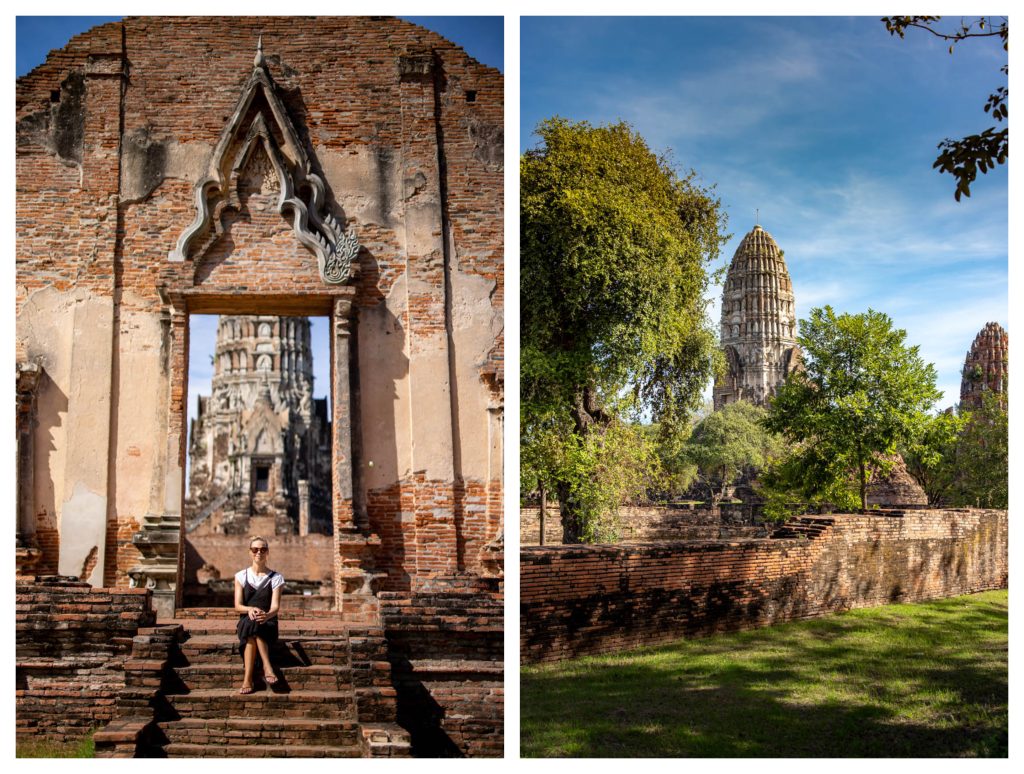
OUR TOP 5 TEMPLES
AND A HIDDEN BUDDHA HEAD
Unfortunately, due to a stomach bug we had to skip the boat trip to one of Ayutthaya’s most famous temples, Wat Chaiwatthanaram, which we had been looking forward to seeing at sunset. With that in mind, here are our 5 favorite temples from our days in Ayutthaya:
- Wat Ratchaburana
- Wat Mahathat
- Wat Phra Si Sanpet
- Wat Phra Ram
- Wat Yai Chai Mongkhon
One temple outside the Historical Park
Wat Yai Chai Mongkhon is not mentioned in our cycling route described above, as it is a newer temple located 20 minutes by bike from the Ayutthaya island. But if you have the time, we can recommend a visit. Alternatively, you can take the trip with a tuk tuk.
The monastery itself was built in 1900 by Kong U Thong, who wanted to create a center for Buddhist studies. It is well-visited by the locals, so do come early before the buses fill up the car park. You get the best view of the temple from the small park, where a Buddha sits at the foot of the striking stupa. In addition, you can take the stairs up to the top, from where you have a view over the city of Ayutthaya.
Tip: Look for a hidden Buddha head
In the parking lot (of all places) at Wat Yai Chai Monkhon, we discovered by chance that one of the trees hides a secret: A small, severed Buddha head that has grown into the roots of a tree. Wat Mahathat is not the only temple where you can experience the mystery.
To our surprise, there are no markings or official guides describing it? But look for the hidden head as you walk from the temple and along the shops selling drinks and souvenirs. It is about the size of a large coconut. Happy treasure hunt …
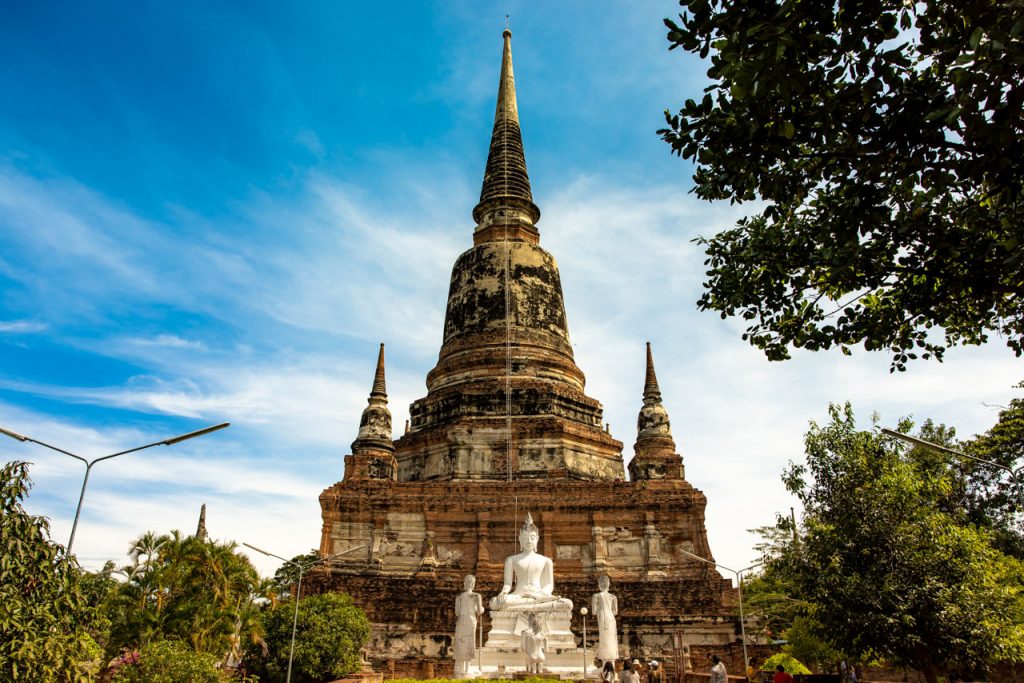
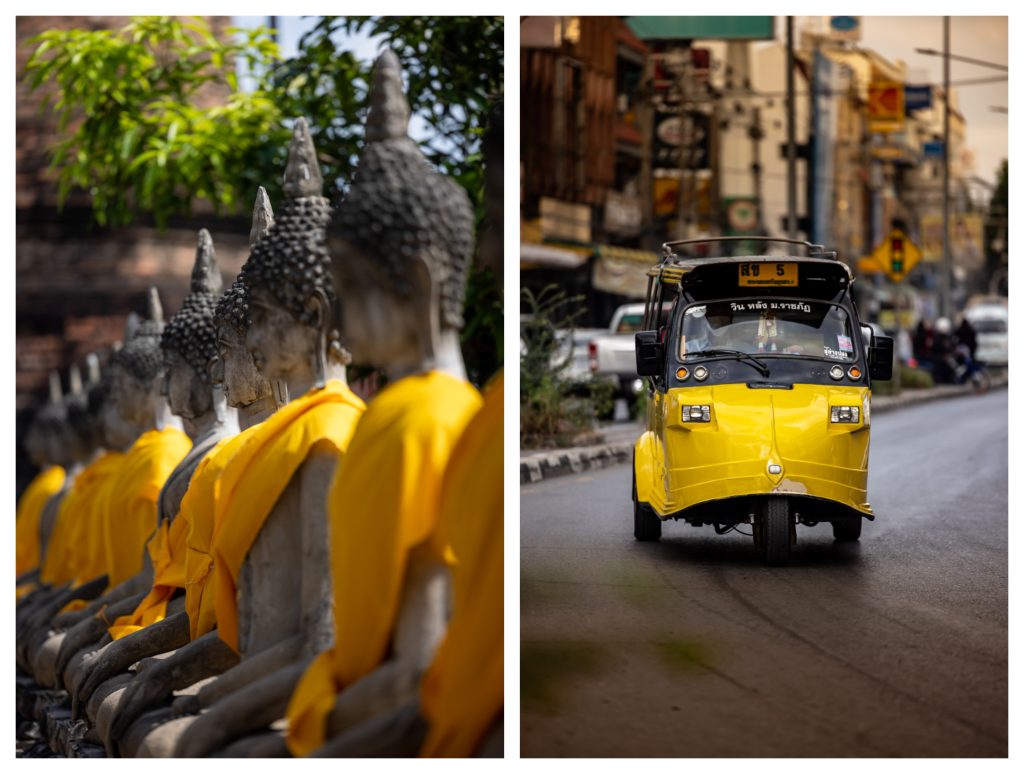
GOOD TO KNOW
BEFORE YOU VISIT THE TEMPLES
Where is Ayutthaya located
Ayutthaya is 80 km north of Bangkok. The ancient capital was stablished by King Ramathibodi in 1350 and strategically located on the island formed by the confluence of the Chao Phraya, Lop Buri, and Pa Sak rivers. Today, Ayutthaya is a typical Thai provincial city with approx. 50,000 inhabitants. The city has grown around the 14km2 island, which today forms the city center and the historic park with the main temples.
Ayutthaya Historcial Park
There are said to be over 400 temples in the provins of Ayutthaya. The most famous temples are part of The Ayutthaya Historical Park and scattered around the island. But none are so far away that you cannot experience them by bike.
Entrance fee
The temples in Ayutthaya Historical Park are separate complexes with their own entrances. Some require an entrance ticket, while others are free. If you plan to visit the six largest, it may be worth buying a temple pass. Individually they cost 50 bhat, while a temple pass costs 220 bhat (2022).
The temples included in the Temple Pass:
- Wat Mahathat
- Wat Ratchaburana
- Wat Phra Ram
- Wat Phra Si Sanphet
- Wat Chaiwatthanaram
- Wat Mayehong
Opening hours
Most of the temples in Ayutthaya Historical Park are open approx. from 8 am to 6 pm. Outside of opening hours you cannot enter the temple complexes, but many are lit up in the evening and still an impressive sight from the other side of the walls.
Find the temples on the map
We found that it can be slightly different how the names of the temples are spelled. Therefore, we have chosen to write the names as they appear on Google Maps, so that you can more easily search for them. Also, see the location of the temples on the official map.
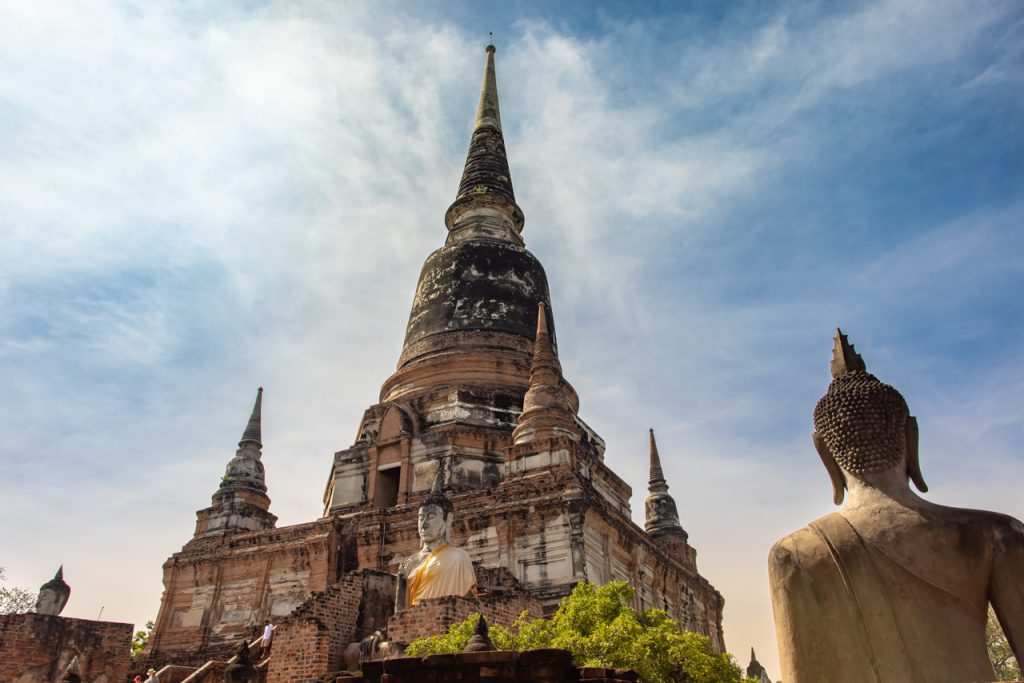
Prepare for the heat
Ayutthaya is known for being a hot pleasure. If you have the time, we recommend that you divide the day so that you visit the temples in the morning and late afternoon, when the sun is more gracious. The ruins and temples offer only sporadic shade. Remember plenty of water, sunscreen, a hat, sunglasses, and a light, loose-fitting outfit.
7 good customs when visiting temples
Even if the locals do not use the ancient temples, they are still religious places where you should behave respectfully.
#1 – Dress code
Although Ayutthaya’s hot and humid climate calls for shorts and tops, it is good custom to dress respectfully when visiting the temples. Both men and women must cover their knees and shoulders. Alternatively, bring a scarf that you can use as a sarong.
#2 – Show respect
It is inappropriate to show caresses and feelings, which is why you never see locals kissing and hugging. Do not raise your voice and avoid loud outbursts, even if it is out of pure excitement. Walk around quietly.
#3 – Don’t pat anyone on the head
The head is considered the most sacred part of the body. Therefore, you must never pat anyone on the head, not even the statues.
#4 – Never point with your feet
In Thailand the feet are considered to be the weakest part of the body. This is why you must never turn the soles of your feet towards others, or use your feet as a pointing tool.
#5 – Shoes off or on?
If you visit temples that are active, you must take off your shoes before entering. But when you walk around the ancient ruins, please keep your shoes on.
#6 – Behavior around Buddha
Do not touch the Buddha statues, or turn your back to them when walking. As much as possible, show your respect by keeping your head lower than theirs.
#7 – Do like the locals
If you are in doubt as to what the correct behaviour is, watch the locals and follow their way of behaving.
How to speak temple lingo
Wat: Temple
Prang: A large tower-like spire
Chedi: A bell-shaped sculpture that houses a Buddha statue or a royal figure
Ubosot: The main prayer room
Viharn: Temple Hall
Stupa: A monument shaped like a hemisphere
How many days to spend in Ayutthaya?
You can easily visit the main temples in one day. But for us, it was nice to spend two nights in the city. That way we could experience the temples from early morning until the high heat and hordes of day-trippers arrived – and continue our temple run before sunset. Moreover, we had a great time experiencing a bit of the city’s local life, the river side, and the markets in the evening.
Is Ayutthaya worth visiting?
Yes! Ayutthaya is certainly worth visiting. Some compare Ayutthaya to Angkor Wat in Cambodia. We think that might be a bit optimistic, as the park’s area is smaller and the separate temple complexes are spread out across the city. But there is no doubt that it is a very special experience to be able to stroll freely around the historic ruins and impressive temples. And best of all, it can easily be experienced on your own.
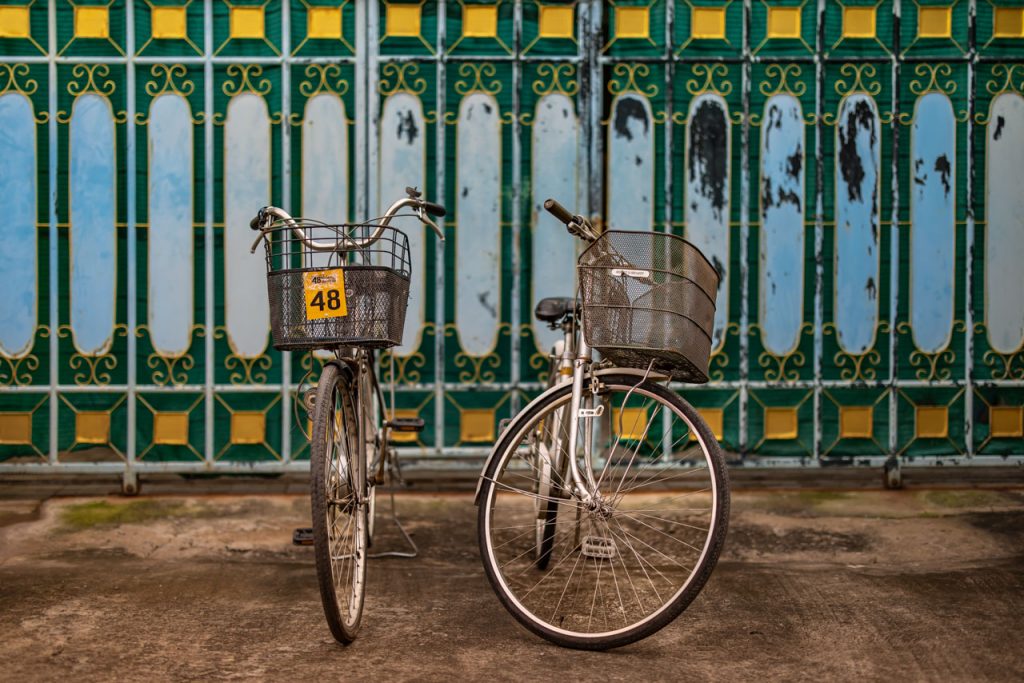
HOW TO GET AROUND
THE TEMPLES OF AYUTTHAYA
There are several guided tours that take you around the temples. They can be booked in Ayutthaya or on a day trip from Bangkok. But it’s also easy to explore the temples on your own.
On foot
If you prefer to walk around to the temples, we recommend that you prioritize those located on the island itself and centered around the three most famous temples: Wat Ratchaburana, Wat Mahathat, and Wat Phra Si Sanpet. If you want to see temples that are a little further away, or on the other side of the river, it’s a good idea to rent a bike, a tuk tuk, or join a boat tour that sails around the island.
Bike
Our preferred way of getting around was by bike. It’s easy to cycle around, and as a bonus you get a little breeze on the way. In many places, there are marked green cycle paths on the asphalt roads, and traffic is manageable on the island itself. If you cycle outside the island, there is more car traffic on the major roads.
You can rent a bike through your hotel or around town. We rented our bikes from Good Luck Guesthouse on Naresaun Soi for 50 bhat per bicycle for a day. If you arrive by train from Bangkok and jump on the taxi boat that shuttles across the river to the island, there is a bicycle rental shop called December House just on the other side. It’s probably a bit more expensive due to the location.
If you rent a bicycle with a basket, you must be careful when using it to store valuables. Our hotel manager told us that several tourists have had their handbags stolen in this way. Also, remember to rent a bicycle with lights if you plan to cycle around in the evening.
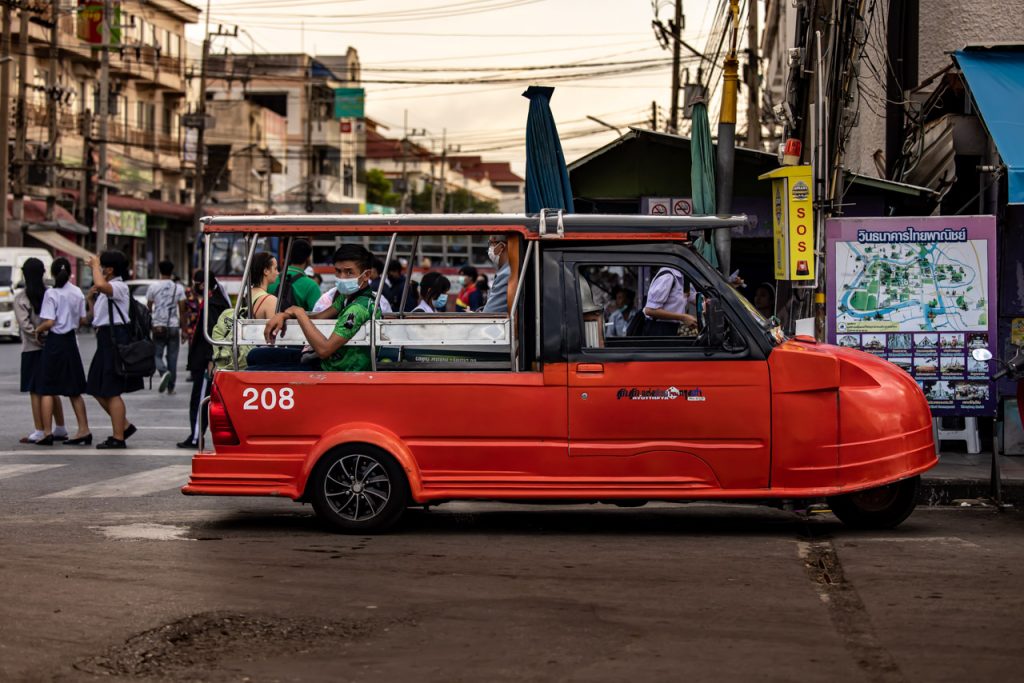
Tuk tuk
You can find tuk tuks all over Ayutthaya, at the train station, and around the temples. You can hire a tuk tuk for a single trip, or for a full day of sightseeing. The drivers are used to a little negotiating, but only to a certain extent, as they relate to set prices. For example, the hourly price is 200 bhat per person, and the trip from the train station to a guest house on the island costs 50 baht per person.
Boat trips around the island
You can hire a private boat, or join one of the many organized boat trips that sails around the island. The boat stops at three main temples along the river: Wat Chaiwatthanaram, Wat Putthai Sawan, and Wat Phanan Choeng Worawihan. Many guesthouses offer to arrange a boat trip for you. The trip costs 200 baht per person (excl. entrance to the temples), takes two hours (4-6pm), and often ends at the Hua Ro Night Market, where you can have dinner.
Taxi boats
In addition, we can recommend that you use the small public taxi boats that connect the riverbanks at two places:
#1 – One of the taxi boats is located a few minute’s walk from the train station. It sails between Puntaogongma Shrine (East Passenger Ferry Landing) and December House (West Passenger Ferry Landing). We used the boat as we arrived by train from Bangkok and walked from the station to our guest house.
#2 – The other boat sails between Wat Phanan Choeng Worawihan and the wharf at Rich Restaurant. We took the bikes with us as we explored the temples outside the city. From here it is also obvious to cycle on to the old districts where the colonists settled. Look for Baan Hollanda and Japanese Village. We didn’t had the time to go there, but it was recommended to us by other travelers.
Price: 10 baht per person / With bicycle: 20 baht per person
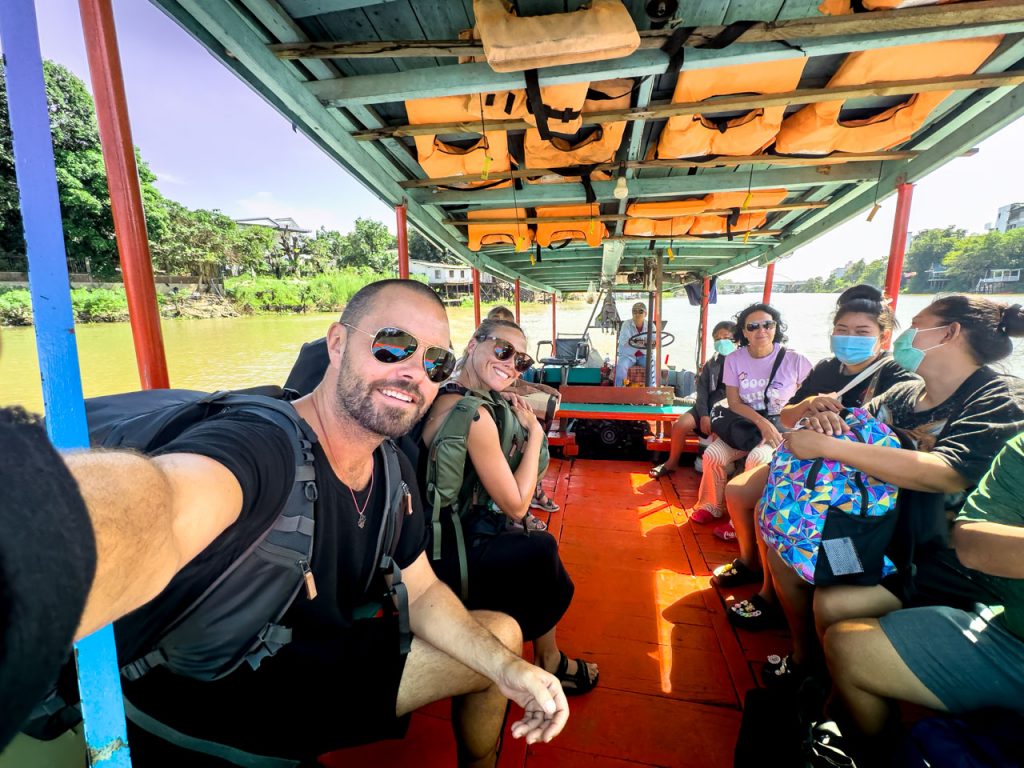
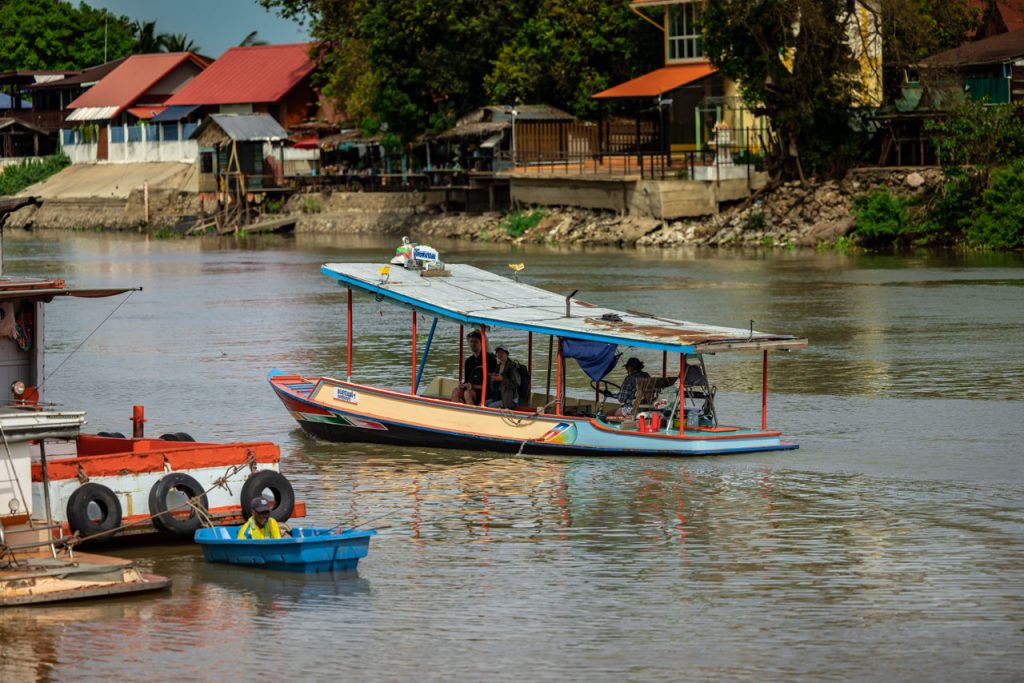
BEST AREA TO STAY
IN AYUTTHAYA
Where to stay
If you choose to spend the night in Ayutthaya, we recommend booking a place on the island. Here you are within walking distance to main temples, the night markets, and several restaurants.
Most hotels and guesthouses are primarily on the eastern side of the island. Here, the city center is located around Naresuan Road, where you will find most shops, supermarkets, eateries, bicycle rental places, as well as the bus station.
If possible, we would recommend that you book a place with a view of the river. It is nice to take a temple break while observing life as it is lived on the rivers that surround the island.
Markets in Ayutthaya
There are two night markets in the old city: Ayutthaya Night Market on Bang Lan Road is the most famous. It is diagonally across from the entrance to Wat Mahathat. The other is Hua Ro Market (sometimes spelled Hua Raw Market) on the island’s northeastern tip.
In the city center you will find Chao Phrom Market. It is the main daily market in Ayutthaya located along Naresuan Road. In this area you will also find shops, restaurants, 7eleven, and a super market.
Outside the city, you’ll find Ayutthaya’s floating market, which is not to be confused with real floating markets in Thailand. This one more resembles a theme park with souvenir shops. You must pay an entrance fee to enter and it’s not worth visiting if you ask us.
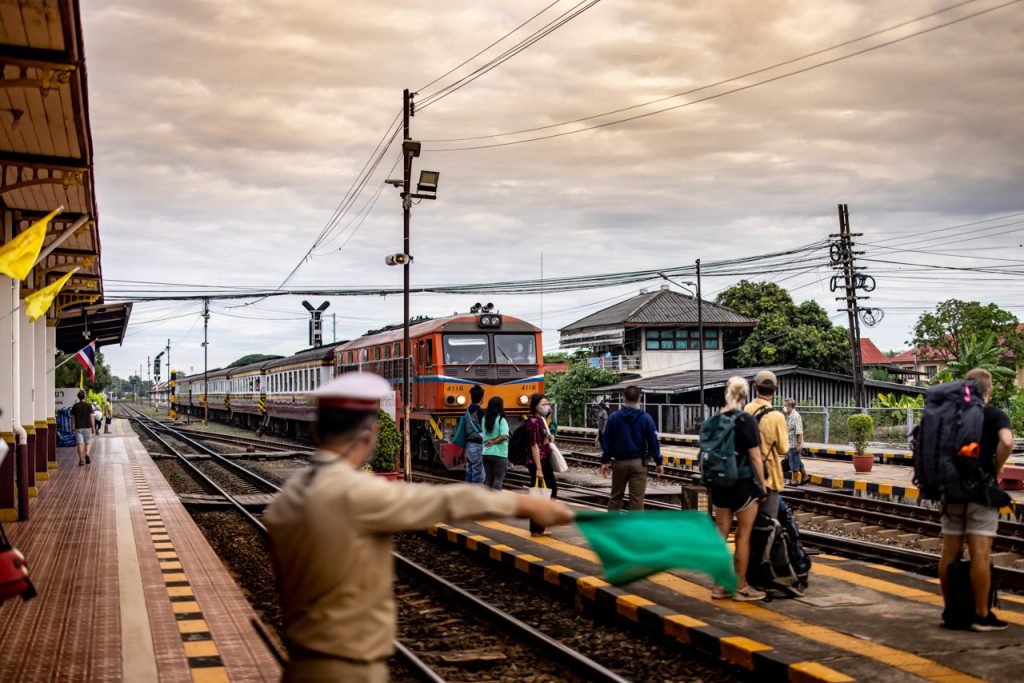
TRANSPORT TO AYUTTHAYA
BY TRAIN, BUS, OR TAXI
There are several ways to travel to Ayutthaya, which is located approx. 80 km north of Bangkok. The most popular means of transportation to Ayutthaya are train, minibus, or organized bus tour. The fastest and most expensive way is by taxi. You can check prices and itineraries on the booking page rome2rio. It is the booking portal that we ourselves use to plan trips and buy tickets online.
In addition, we have come across organizers offering boat trips from Bangkok to Ayutthaya. But as far as we hear from other travelers, the trip is a hoax, as the main part of the trip will still be by bus and only includes a short boat trip close to Ayutthaya. So please double-check if you are considering that option.
Our train journey from Bangkok
Ayutthaya was the first stop on our tour of Northern Thailand. We chose to take the train from the main train station in Bangkok, Hua Lamphong Station, from which there are several daily departures. The ticket price depends on the type of train and choice of seat ticket ( class).
We chose the slow 3rd class train which only costs 15 baht per person (2022). It was not necessary to book a ticket in advance. The 3rd class seats are hard, upright plastic seats, and the open windows offer natural air-conditioning. The toilets are the classic stand-up-Asia-version. But the compartment was clean, the people were helpful, and even if we got a little sore in the butt, it was a good trip.
Hua Lamphong train station in Bangkok
The more than 100-year-old railway station Hua Lamphong in Bangkok will soon become an attraction in itself. According to the rumor, the Bangkok authorities were in 2021 planning to convert the station into a museum and thus move all train traffic to Bang Sue Station. However, when we left, the railway station in 2022 it was still in use.
Train schedule to Ayutthaya
The trains are notoriously late, so allow for a little extra travel time. Our trip was estimated to take 1 hour and 40 minutes, but we were lucky and only arrived 10 minutes later than planned. Please see the train schedule here.
Tips to the train journey
The drive itself is not a scenic experience. Most of the trip runs through Bangkok’s suburbs, so bring a good book for the trip. If you get thirsty or hungry for a snack, vendors will come through the compartment with juice, soda, chips, and other local snacks. Remember hand sanitizer and toilet paper if you plot to explore the toilets.
Ayutthaya Train Station
The train station is not on the island, but just across the river. From here you either walk or take one of the many tuk tuks outside the station. It costs 50 baht per person. person to drive to a hotel in the city. The city is no bigger than that it takes a maximum of 15-20 minutes to drive from the station to a hotel.
From the train to the hotel
If you choose to walk from the train station, you can take the small taxi boat that sails across the river and docks a few minutes’ walk from the train station. The boat shuttles between Puntaogongma Shrine (East Passenger Ferry Landing) and December House (West Passenger Ferry Landing). The boat costs 10 baht per person and sails when it is full. So if you have to catch a train, it is safer to take a tuk-tuk.
Have a great trip to Ayutthaya!
We hope that our travel guide to Ayutthaya is useful and that you will have a wonderful time. If you have any questions, feel free to write to us in the comment field below.

